Angel Cake with Cherry Berry Coulis by DK on Aug 16, 2012

Egg white is my family's best friend. It started with cutting down yolks cos of cholesterol. You sure have to think about it if you are emptying one family size egg carton each week! - only that here we are talking about one person - the husband. So, I started using more egg whites with some yolks. Well, now it turns out, his taste for yolks has depleted and he doesn't like it as much as he used to! But that's for another post. I remember the very first time I made this cake. I had separated the egg whites for an omelet and in the last minute did not get to make it. I did not like to keep it in the fridge and looked around the net for something that used a reasonable quantity of egg whites.
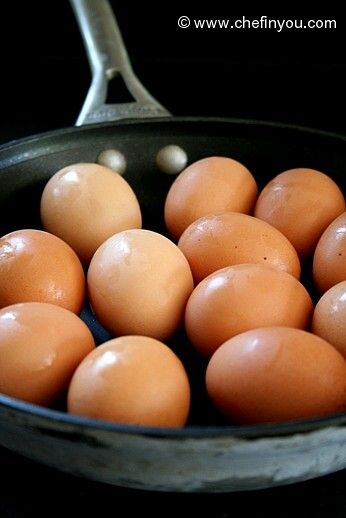
I chanced upon this recipe for Angel Food Cake and was intrigued. I was a naive baker then but still picked up courage to try it out. The end result looked so good that I was ECSTATIC to say the least. It was like "I" made this beauty. I will leave it to your imagination to conjure up my husband's face, when he enters home to a jumping wife, who screams her heart out when he tries to grab a piece from it ("Are you kidding me? How can you think of spoiling it? can't you see how beautiful it looks?"). Of course his comment of "Well- what's the point of this cake then?" fell on deaf ears :) :)
- Cook time:
- Prep time:
- Serves: 6 people
- Yields: Makes 10-12 Servings
Ingredients
- For the Cake
- 1-3/4 cups sugar, divided
- 1/4 tsp salt
- 1 cup cake flour, sifted
- 12 egg whites, at room temperature (see Tips)
- 1/3 cup warm water
- 1 tsp Vanilla extract
- 1-1/2 tsp cream of tartar
- For the Berry Cherry Coulis (Sauce)
- 4 cups of berries (strawberries, raspberries, blackberries, blueberries) & cherries
- Honey to taste
Tips
1. Egg Whites: Using room temperature eggs, tend to produce more volume. To bring it to room temperature, simply place your eggs on counter top for 15-30 minutes (depending on the climate). If you are short on time, then simply place the eggs in a bowl and place the bowl over warm water (not hot) for 5-10 minutes.
Method
1.
Preheat oven to 350 degrees F. Sift 3/4 + 2 tbsp sugar with the salt and the cake flour
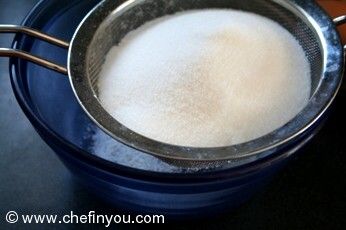
2.
and combine well.
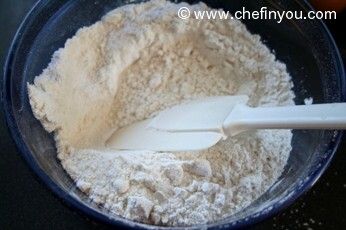
3.
Be careful to separate the egg whites from the yolks since even a wee little bit of yolk can make this a flop show. Just to be safe, I break open and separate each egg first in a small bowl and then making sure its yolk free, drop it to the large bowl (make sure the large bowl is clean and dry) . Freshest eggs separate easily.
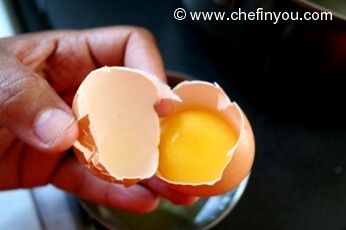
4.
Now you can either use a copper bowl or a large stainless steel . Do not use aluminum or wooden bowls since aluminum can turn the egg whites into gray and wooden bowls tend to generally absorb other flavors from earlier usage and that might retard the egg whites. If using Copper bowls, you can skip Cream of tartar since copper bowl contains an ion which reacts chemically with egg whites that in turn helps to produce fluffy whites. If using stainless steel, use a vessel that has straight sides.

5.
Using a whisk, thoroughly combine egg whites, water, vanilla extract, and cream of tartar.
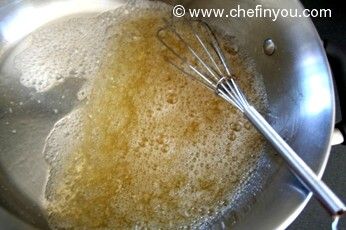
6.
After 2 minutes, you will notice its more foamy,

7.
switch to a hand mixer.
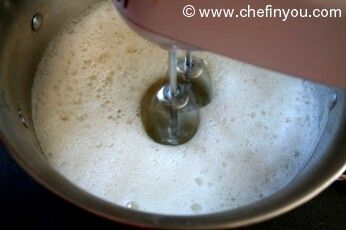
8.
Slowly sift the reserved sugar, beating continuously at medium speed.
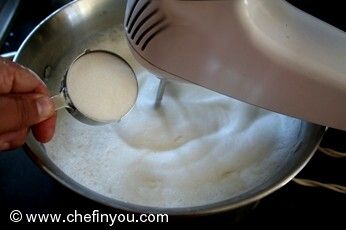
9.
Once you have achieved medium peaks, (do not let it sit for long )
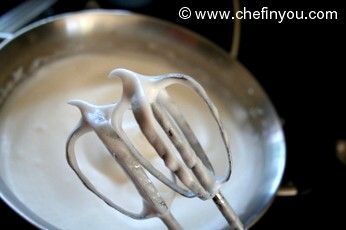
10.
sift enough of the flour mixture in to dust the top of the foam.
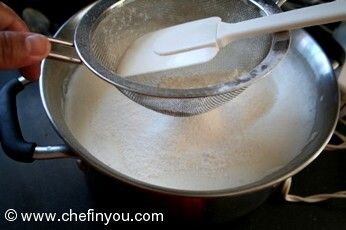
11.
Using a spatula fold in gently. Continue until all of the flour mixture is incorporated.
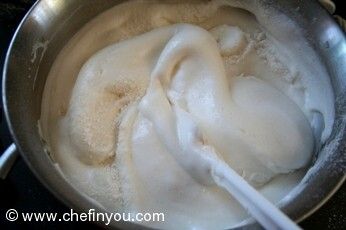
12.
Carefully spoon mixture into an ungreased tube pan. A tube pan is traditionally used for this cake, since the cake rises quite high and it needs the support of tall sides. Without the "pillar" in the middle the cake would sink "plop" in the middle. You do not grease it since the egg whites tend to stick and this stickiness is what that helps the cake to climb in the first place :) [Gee - At times Science isn't that mumbo jumbo as it looks to be! OK may be its the food language that did it for me, but nevertheless ...;))

13.
Once transferred, do not pat or bang the pan on the counter top. It will help the air escape from the batter and we don't want that to happen. Just give it a slight half spins.

14.
Bake for 35 minutes before checking for doneness with a wooden skewer. (When inserted halfway between the inner and outer wall, the skewer should come out dry).
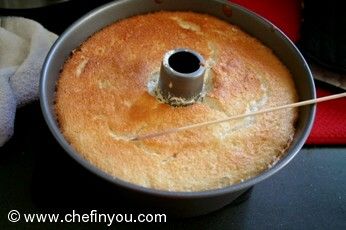
15.
Place a cookie sheet on top of the pan.
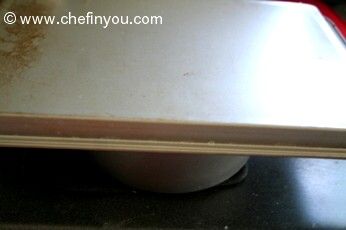
16.
Then cool it upside down for at least an hour before removing from pan. This is done in order to set the cake first. Removing it before cooling completely will plop the cake in the middle.
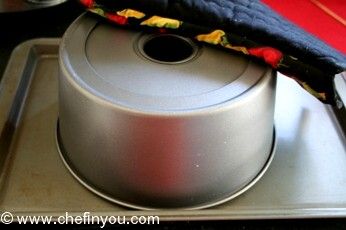
17.
Once cooled, turn it upside down. Using a knife, cut down on the sides to loosen up the pan. It will be sticky, hence do it gently.
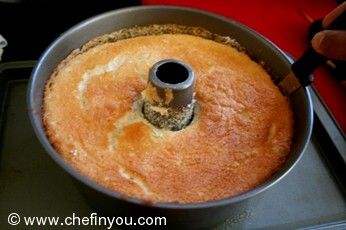
18.
Remember to do the same in the middle too.

19.
Turn it upside down again and then repeat for the base.
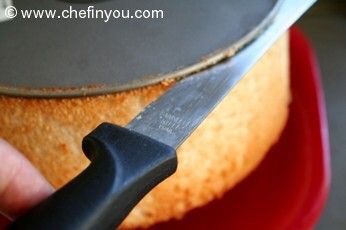
20.
Remove the base of the pan. There...the cake is ready. A little of my cake still managed to stick tight to the bottom - but hey, nothing like scraping off sticky cake from the cake bottom! (Yes! I give excuses for a bad job - so what! Hmffff.....)

Cut a piece and enjoy with Berry-cherry coulis and an additional garnish of berries. I prepared the Berry Cherry Sauce this way.
 Trust me, that spongy cake soaked in sweet-tart sauce tastes so refreshing though light. When you talk about eating dessert yet not worrying about calories - then this one "takes the cake" (Pun intended!).
Trust me, that spongy cake soaked in sweet-tart sauce tastes so refreshing though light. When you talk about eating dessert yet not worrying about calories - then this one "takes the cake" (Pun intended!).

 Trust me, that spongy cake soaked in sweet-tart sauce tastes so refreshing though light. When you talk about eating dessert yet not worrying about calories - then this one "takes the cake" (Pun intended!).
Trust me, that spongy cake soaked in sweet-tart sauce tastes so refreshing though light. When you talk about eating dessert yet not worrying about calories - then this one "takes the cake" (Pun intended!).

Filed Under these categories
- 226 American
- 276 Anniversary
- 51 Cakes
- 227 Desserts/Sweets
- 77 Healthy Baking
- 705 Kid Friendly
- 305 Mother's Day
- 384 Nuts Free
- 371 Parties
- 227 Picnic
- 192 Potluck
- 398 Pregnancy
- 224 Protein Rich
- 330 Super Bowl
- 248 Valentine's Day
Related Articles
Recipe Reference
recipe courtesy alton brown; tips and techniques, courtesy Alton brown and few from my own research from various sources.
Related Posts
Very Berry Coffee Cake By DK on Oct 3, 2011
Pineapple Carrot Upside Down cake By DK on Oct 1, 2012
Moist Quinoa Chocolate Cake By DK on Dec 23, 2012
Strawberry Shortcake Cake By DK on May 2, 2014
Eggless Vanilla Sponge (Layer) Cake By DK on Feb 11, 2014
Wacky Cake (Vegan Chocolate Cake) By DK on May 14, 2014
Leave a Reply
I love to hear from you! I read each and every comment, and will get
back as soon as I am able to.
2 Member Reviews
By Ramya on Dec 7, 2013
Thanks DK
The sauce was the star of the dish
By Neha on Aug 17, 2013
I tried this recipe with raspberry sauce and it came out very well. Thanks for sharing Divya.
8 Comments
By Lisa on Apr 12, 2013
Is there a way to sub. the sugar without ruining the cake?
By Sahana on Oct 4, 2012
awsome DK
By Ann on Sep 7, 2012
Hi DK, I am a semi- vegan and strict vegetarian with the exception just for yogurt. I have tried most of your cake recipes using yogurt as a substitute including this one and it turned out equally good. The only precaution I would say must be taken when using yogurt is use the one with whole milk and use a bit less than suggested as it will add in more moisture than egg. Hope this helps Pure vege..go ahead you can still make this recipe your way!
By manisha on Aug 18, 2012
hi DK...can i use ready eggwhite mix instead of real eggs?
I do not have personal experience, hence have no idea. But see if this thread at KingArthurFlour.com is of any help to you --DK
By Shannon on Aug 17, 2012
Can you use a gluten free flour instead of cake flour?
I think you can. I googled and found this recipe at Taste Of Home website. See if it gives you an idea --DK
By usha on Aug 16, 2012
hi..ur cake looks lovely..in many recipe books i have seen using tartar but have no idea wat it is?Can u throw some light on it and can you suggest any alternative..or where can i find it here(Vizag,AP,India)..Too many questions na??
Take ur time ;-)..Love ya..Keep cooking and keep smiling..
By Pure vege! on Aug 16, 2012
Can you tell me how to make this eggless? :-P
Don't make it :-P Try something else from here :) Eggless Cake Recipes --DK
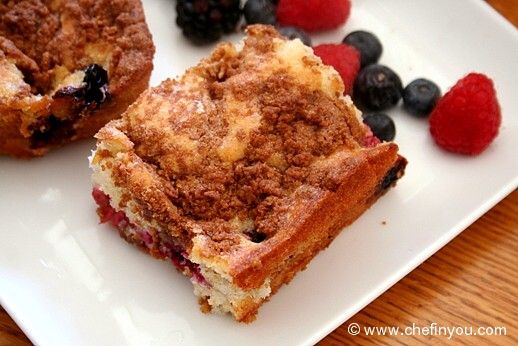





By everythingofcooking on Jan 27, 2014